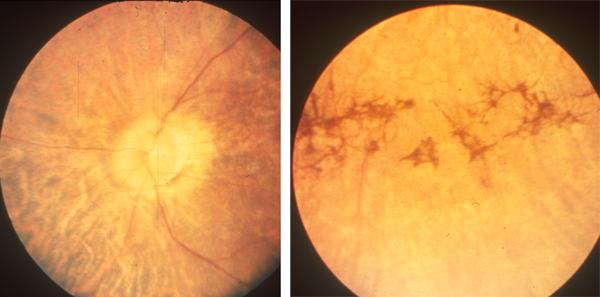NOV 08, 2015
By Elias I. Traboulsi, MD
A Compendium of Inherited Disorders and the Eye, Oxford University Press
Genetics
Also called Bassen-Kornzweig syndrome
OMIM Numbers
Inheritance
Gene/Gene Map
- Microsomal triglyceride transfer protein deficiency
- 4q22-q24
Epidemiology
- Most cases with this extremely rare disease have been in Eastern European (Ashkenazi) Jews, but it has been reported in other populations.
Clinical Findings
- Lipid malabsorption in infancy results in a deficiency of the fat-soluble vitamins A, E, and, less commonly, K. Although lipid is able to enter the intestinal mucosal epithelium, its exit is blocked. Fat-soluble vitamins cannot be normally incorporated into chylomicra for transportation to the liver from the intestine.
- Steatorrhea with abdominal distension, failure to thrive, malnutrition, and spinal curvature beginning in the first few months of life are all present.
- Patients develop spinocerebellar ataxia, areflexia, and weakness, accompanying a diffuse neuromuscular disease that resembles Friedreich ataxia.
- There are crenated or "thorny" red cells on blood smear (acanthocytosis) (Figure 1). Plasma cholesterol level is less than l00 mg/dl. There is complete absence of apolipoprotein B and lipoproteins from plasma, and absence of apo-LDL (low-density lipoprotein) from plasma confirms the diagnosis.

Figure 1. Posterior pole of patient with abetalipoproteinemia showing pale optic nerve head, attenuated blood vessels and atrophic retina (left). Midperipheral bony spicule pigmentary changes in same patient (right).(Courtesy of Dr. W. R. Green)
Ocular Findings
- Night blindness develops, with retinal degeneration and later onset of pigmentary changes secondary to vitamin A deficiency. White dots are present throughout the fundus and are most numerous in the periphery. A retinitis pigmentosa-like picture eventually ensues.
- Angioid streaks have been reported in a few cases and can be complicated by subretinal neovascularization.
- Reduced electroretinographic responses are present early in the course of the disease.
- Ptosis, ophthalmoplegia, strabismus, and nystagmus are less common findings.
Therapeutic Aspects
- Serum vitamin A levels should be determined. One oral dose of 200,000 IU of vitamin A palmitate maintains serum levels in the normal range for several months. Additional doses are given depending on serum levels of vitamin A.
- Vitamin K supplementation may be necessary to prevent bleeding.
- Vitamin E supplementation has been shown to arrest neuropathy and myopathy.
- Life expectancy is reduced, and death often occurs from cardiac arrhythmias.
References
- Cogan DG, Rodrigues M, Chu FC, et al: Ocular abnormalities in abetalipoproteinemia: a clinicopathologic correlation. Ophthalmology. 1984; 91:991-998.
- Duker JS, Belmon J, Bosley TM: Angioid streaks associated with abetalipoproteinemia. Arch Ophthalmol. 1987; 105:1173-1174.
- Luckenbach MW, Green WR, Miller NR, et al: Ocular clinicopathologic correlation of Hallervoden-Spatz syndrome with acanthocytosis and pigmentary retinopathy. Am J Ophthalmol. 1983; 95:369-382.
- Runge P, Muller PR, McAlliter J, et al: Oral vitamin E supplements can prevent the retinopathy of abetalipoproteinemia. Br J Ophthalmol. 1986; 70:166-173.
- Sperling MA, Hiles DA, Kennerdell JS: Electroretinographic responses following vitamin A therapy in abeta-lipoproteinemia. Am J Ophthalmoli 1972; 72:342-351.
- Wetterau JR, Aggerbeck LP, Bouma ME, et al: Absence of microsomal triglyceride transfer protein in individuals with abetalipoproteinemia. Science. 1992; 258:999-1001.
Resources
Traboulsi EI. Compendium of Inherited Disorders and the Eye. New York: Oxford University Press; 2005. Adapted with permission.